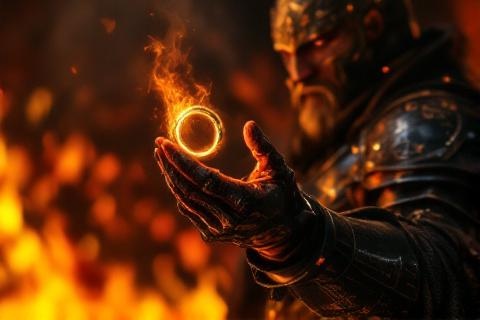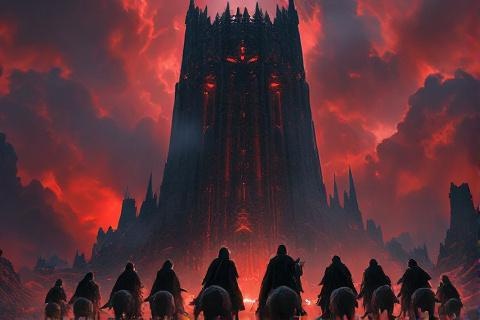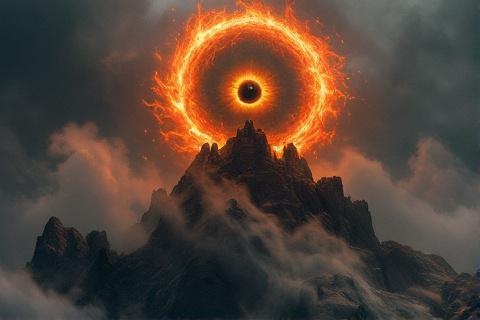
Sauron: Dark Lord of Mordor
Unmasking Middle-earth's Ultimate Antagonist
Origins as a Maia of Aulë

In the beginning of Arda, Sauron was known as Mairon, one of the powerful
Maiar spirits who descended into the world during its formation.
He served in the halls of Aulë the Smith, where his great intelligence and love
for order flourished among the crafts and works of the great Vala. As one of the
most powerful of the Maiar, Mairon possessed abilities far beyond those of
mortal beings and learned much from Aulë's teachings.
Among all the Maiar, Mairon distinguished himself through his extraordinary
capabilities in crafting and organization. His works in Aulë's forges were
renowned for their perfection and complexity, showcasing an understanding of the
physical world that few could match. This mastery extended beyond mere
craftsmanship to include a deep comprehension of the underlying structures and
laws that governed Arda itself.
The seeds of Mairon's downfall lay in his overwhelming desire for order and
efficiency in all things. His pursuit of perfection, though noble in its
inception, gradually transformed into an obsession with control and domination.
This corruption of his original purpose happened so subtly that even Mairon
himself might not have recognized it at first, as his drive for order became
increasingly twisted into a desire to impose his will upon others.
The Seduction by Melkor
Melkor, the most powerful of the Valar,
recognized in Mairon a kindred spirit who could be turned to his purposes. He
tempted the Maia with promises of achieving greater works more quickly, without
the restrictions and careful deliberation required by Aulë. These promises
resonated deeply with Mairon's increasing impatience with what he perceived as
the unnecessary constraints placed upon his abilities.
During the Years of the Lamps, Mairon maintained his
position in Aulë's service while secretly beginning to align himself with
Melkor's purposes. His betrayal was so subtle and carefully managed that for a
long time, none suspected his growing allegiance to the Dark Power. He continued
to appear fair and reasonable while his heart turned ever more toward darkness.
As Melkor's most capable and trusted servant, Mairon proved his worth through
cunning and efficiency rather than mere destruction. His organizational
abilities and strategic mind made him invaluable to his new master's plans. He
established himself as the Lord of Werewolves in Tol-in-Gaurhoth, commanding
fell creatures and weaving shadows to serve his purposes.
From his fortress of Tol-in-Gaurhoth, formerly the fair isle of Tol
Sirion, Sauron commanded Melkor's forces with terrible
efficiency. He became known as a master of shadows and deceits, using both
physical might and cunning to extend his master's power. His ability to maintain
order among Melkor's chaotic forces proved essential to their effectiveness in
the wars against the Elves.
The Fair Form of Annatar

Following Morgoth's defeat in the War of Wrath, Sauron
adopted his most cunning disguise yet. He took on the form of Annatar, the Lord
of Gifts, appearing as a being of remarkable beauty and wisdom. This fair form
was carefully chosen to appeal to the Elves' love of knowledge and
craftsmanship, making him seem like a natural ally in their efforts to preserve
and enhance Middle-earth.
Through his guise as Annatar, Sauron successfully deceived many of the Elves,
particularly the Gwaith-i-Mírdain, the Brotherhood of Jewelsmiths in
Eregion. His vast knowledge of crafting and lore proved
irresistible to these skilled artisans, who welcomed him eagerly into their
councils. The Elves of Eregion were especially receptive to his teachings,
though some leaders like Gil-galad and Galadriel
remained suspicious of his true nature.
While working alongside the Elven-smiths, Sauron shared his knowledge of
ring-making, carefully concealing his ultimate purpose. He assisted in the
creation of the Seven Rings for the
Dwarf-lords and the Nine for Mortal Men, while the
Elves independently crafted the Three Rings of Power. Throughout this process,
he maintained his benevolent facade while secretly preparing for the next phase
of his grand design.
The Forging of the One Ring

In the fires of Orodruin, later known as Mount Doom, Sauron forged the One
Ring in secret. This masterwork of dark craftsmanship was
designed to be the master ring that would control all others, incorporating
techniques he had taught the Elven-smiths while adding his own malevolent
innovations. The creation of the Ring was the culmination of centuries of
planning and preparation.
The forging of the One Ring required Sauron to invest much of his native power
into the artifact, making it an extension of his own being. This was not a
diminishment but rather a calculated sacrifice, as it allowed him to extend his
influence far beyond his physical form. The Ring became the foundation of his
power, enhancing his natural abilities and providing him with the means to
dominate other ring-bearers.
When Sauron placed the One Ring upon his finger and spoke the fateful words of
binding, the Elves who wore the Three Rings immediately became aware of his
presence and true purpose. This moment of revelation shattered the trust between
Sauron and the Elves, as they finally understood the full scope of his
deception. The Elven-smiths quickly removed their rings, foiling his immediate
plan to dominate them.
Rise as the Dark Lord

In the volcanic region of Mordor, Sauron established his realm
and began the construction of Barad-dûr, the Dark Tower. This fortress, built
over centuries with the power of the One Ring, became the most formidable
structure in Middle-earth. Its foundations were so thoroughly imbued with the
Ring's power that they would endure as long as the Ring itself existed.
The Nine Rings given to Mortal Men proved to be Sauron's most effective tools of
corruption. The kings who received these rings were gradually enslaved to his
will, becoming the dreaded Nazgûl or Ring-wraiths. These
once-great rulers of Men became his most terrible servants, their very presence
inspiring fear and despair in all who encountered them.
Through a combination of military might and careful manipulation, Sauron
extended his influence across vast regions of Middle-earth. His armies of
Orcs, trolls, and corrupted Men grew ever larger, while his
diplomatic efforts brought many Eastern and Southern peoples under his sway. His
strategies balanced force with cunning, using promises of power and revenge to
turn potential enemies into allies.
During the Dark Years of the Second Age, Sauron's dominion
reached its height, earning him the title 'Lord of the Earth' among his servants
and subjects. His influence extended far beyond Mordor's boundaries, with many
realms of Men falling under his shadow. Even those who opposed him were forced
to acknowledge his power, as his armies and agents seemed to be everywhere.
The War of the Elves and Sauron
Once the Elves understood Sauron's true intentions, open war became inevitable.
He launched a massive assault against the realms of the Elves, focusing
particularly on Eregion where the Rings of Power had been forged. His forces
overwhelmed the defenses of the Elven-smiths, determined to seize all the Rings
of Power for himself.
The destruction of Eregion was complete and terrible. The great forges and
workshops of the Gwaith-i-Mírdain were demolished, and many of the greatest
Elven-smiths were slain or captured. The surviving Noldor were scattered,
fleeing to distant havens like Imladris and Lindon. Though Sauron captured many
lesser rings, the Three Rings of the Elves eluded him.
Sauron's campaign of conquest faced its first major setback when the realm of
Númenor, then at the height of its power, came to the aid of
the Elves. The Númenórean forces, led by Tar-Minastir, proved too strong for
even Sauron's armies to withstand. This intervention forced Sauron to retreat,
though he would not forget this humiliation and would later exact a terrible
revenge.
The Downfall of Númenor

When confronted by the overwhelming might of Númenor's army under Ar-Pharazôn,
Sauron made a calculated decision to surrender without battle. This apparent
submission masked his true intention to corrupt Númenor from within, using his
cunning and persuasive powers to achieve what military might could not. His
strategy proved devastatingly effective as he rose from prisoner to the king's
most trusted advisor.
Through careful manipulation and exploitation of the Númenóreans' pride and fear
of death, Sauron convinced King Ar-Pharazôn to challenge the ban of the Valar.
His honeyed words encouraged the king's existing doubts about the powers in the
West, suggesting that immortality could be seized by force. This counsel led to
the greatest catastrophe of the Second Age.
The destruction of Númenor through divine intervention caught even Sauron by
surprise. Though his physical form was destroyed in the cataclysm, his spirit
endured due to the preserving power of the One Ring. However, he lost forever
the ability to take on a fair appearance, his true nature now reflected in his
physical form.
Sauron's return to Middle-earth marked his final transformation into the Dark
Lord of legend. His new form was terrible to behold, radiating malevolence and
inspiring paralyzing fear in all but the most courageous. From his restored
fortress of Barad-dûr, he began rebuilding his power, though now unable to hide
behind any pleasant disguise.
Powers and Abilities
Among Sauron's most formidable abilities was his mastery over shadows and
illusions, skills he had perfected since his early days serving Morgoth. He
could create powerful deceits that could fool even the wise, and his control
over darkness allowed him to spread fear and confusion among his enemies. These
abilities made him particularly dangerous, as he could strike at the minds of
his opponents before engaging them in physical combat.
As a former disciple of Aulë, Sauron retained and expanded upon his
extraordinary crafting abilities throughout his long existence. His
understanding of the physical world and its mechanisms surpassed that of any
other being in Middle-earth during the Second Age. This knowledge enabled him to
create works of both terrible power and subtle influence, with the Rings of
Power standing as his greatest achievement.
Sauron's dominion over dark creatures was absolute, commanding vast armies of
Orcs, Trolls, and other fell beings. His will could reach across great distances
to control his servants, particularly through the Nine Rings that bound the
Nazgûl to his service. Even wild and fearsome creatures like the great wolves
and vampires of the First Age had been subject to his command.
His knowledge of ring-lore was unmatched in Middle-earth, surpassing even that
of the Elven-smiths he had taught. This expertise extended to many other ancient
and powerful magics, including necromancy and various forms of sorcery. His
understanding of the secret arts was so profound that he could corrupt and twist
the natural world to serve his purposes.
Perhaps most insidious was Sauron's ability to dominate the wills of others.
Through various means, from the Rings of Power to his own innate abilities, he
could bend lesser beings to his purpose. Even without direct control, his
influence could corrupt the hearts and minds of those who came into contact with
his works or his servants.
Legacy and Influence

The influence of Sauron's power and malice extended far beyond his physical
presence, affecting the development and fate of Middle-earth's peoples for
thousands of years. His actions during the Second Age created ripples that would
continue to shape events well into the Fourth Age and beyond. The fear and
corruption he spread became deeply embedded in the very fabric of Middle-earth's
societies.
The creation of the Ring-wraiths stands as one of Sauron's most enduring
achievements in corrupting the Free Peoples. These once-noble kings of Men
became eternal servants of darkness, their very existence a testament to the
Dark Lord's power to corrupt and dominate. Beyond the Nazgûl, entire peoples and
cultures fell under his sway, particularly in the East and South, where his
influence would remain strong even after his final defeat.
Even after Sauron's physical defeat at the end of the Second Age, his shadow
lingered heavily over the Third Age. The One Ring's continued existence meant
that his power was never truly broken, and the fear of his return shaped the
policies and actions of the Wise. The Watchful Peace and the guard kept over
Mordor's borders testified to the lasting impact of his malice, while the
gradual decline of the Elven realms and the fading of magic from Middle-earth
could be traced to the long war against his influence.
